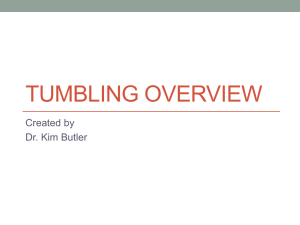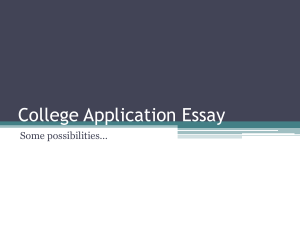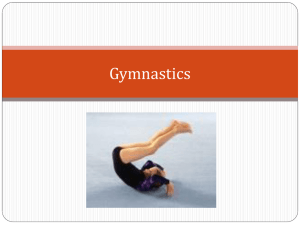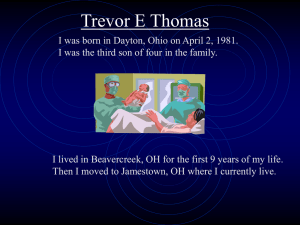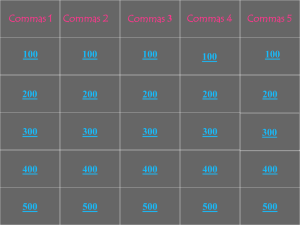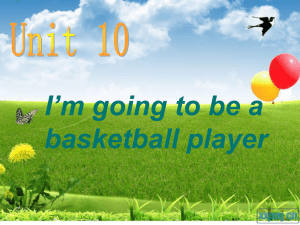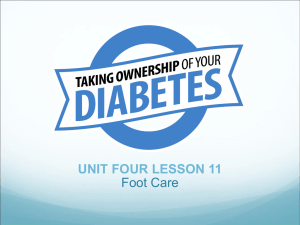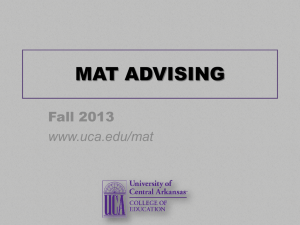HSCII Motor Skills EOC Study Guide
advertisement
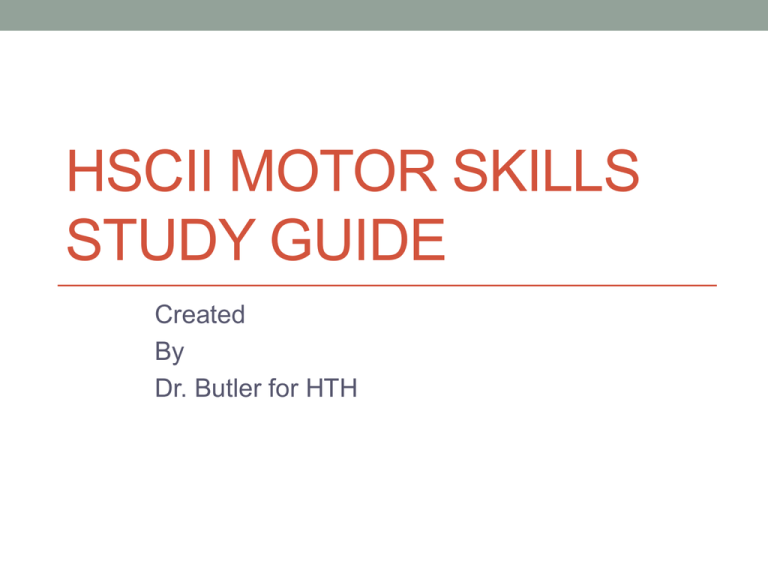
HSCII MOTOR SKILLS STUDY GUIDE Created By Dr. Butler for HTH • Standard 1.1 Combine and apply movement patterns, simple to complex, in self defense, tumbling, and team activities. REVIEW OF TUMBLING • Standard 1.1 Combine and apply movement patterns, simple to complex, in self defense, tumbling, and team activities. History of Gymnastics • 1700s – Gymnastics • • • • begins in Germany 1800s – Leotard invented 1896 – First gymnastics in Olympics (men) 1928 – First women gymnastics in Olympics 1976 – First perfect score (Nadia Comaneci from Romania scores 10.0 floor routine) History of Gymnastics Continued 1984 – USA men’s team wins gold in Olympics 1996 – USA Kerri Strug sticks landing on vault with one foot (injured ankle previously) Log Roll • Lay on back with arms extended over head. • Turn head and shoulders to the left or right. • Keep body straight. • Roll around body. Front Shoulder Roll • Drop one shoulder. • Fall forward placing one arm diagonally across body. • Tilt head forward and to the side. • Tuck chin to chest. • Roll over extended arm, shoulder, and back. V Sit • Sit on the floor with your knees bent and arms extended. • Extend your knees to assume a "V" shape. • Support your body weight on your seat. Front Seat Support • Sit on the floor with legs straight and hands flat on the floor between hips and knees. • Point your fingers toward your feet. • Push down against the floor so that your hips come up off the floor. • Lift your heels and support your weight on your hands. Forward Roll • Assume a squat position. • Tuck chin to your chest. • Push against the ground • • • • • with your feet. Lift your hips. Roll over your rounded back. Tuck your legs. Push off with your hands. Roll forward to a squat position. Back Shoulder Roll • From a squat position, roll backward over one shoulder. • Keep knees close to your chest. • Continue moving legs over your body until toes touch the floor. • Turn your head and look toward your knees. • Bring your arms off the floor to complete the roll. Backward Roll • Assume a squat position • • • • • with your back toward the mat. Roll over rounded back. Keep your knees close to your chest. Reach over your shoulders with your hands in a palms up position. Push your hands against the mat to take the weight off your neck. Bring your body to a squat position. Switcheroo • Perform a front lunge with • • • • • • your arms over your head. Bend forward at your hips. Place your hands on the mat. Kick your back leg up followed by your front leg. Scissor your legs in the air. Land with your rear leg in the front. Land with your front leg in the rear. Teeter Totter • Perform a front lunge with • • • • • • • arms overhead. Bend forward at your hips. Place your hands on the mat. Kick up your back leg up followed by your front leg. Hold your feet together for a moment in the handstand position. Scissor your legs in the air. Land with your rear leg in the front. Land with your front leg in the rear. Handstand 1. Start with legs apart 2. 3. 4. 5. and hands over head. Bend forward at your hips. Place both hands on the mat. Kick legs up. Hold legs together in a straight line. Tripod • Squat down. • Place your hands and head on the mat in a triangular position. • Place your knees on your elbows. • Maintain a balanced position. Three Point Tip Up • Squat down. • Place your hands flat on the • • • • • • mat. Point your fingertips forward. Position your elbows inside your legs. Press your elbows against the inner part of your lower thighs. Lean forward. Transfer your weight to your bent elbows and hands. Lower your forehead to the mat. Headstand – Balance Inversion • Squat down. • Place your hands and head on the mat in a triangular position. • Move both feet slowly upward over the your head. • Position your feet together with your legs straight and your toes pointed. • Maintain a balanced position. Round Off- Hand-Hand-Both Feet • Start with slight run. • Push off with right foot • • • • • • then left foot. Place hands close together. Keep arms straight and your head up. Push off with both hands. Bring your feet together. Make a quarter turn. Bend at your waist to land on both feet. Cartwheel –Hand-Hand-Foot-Foot • Place your hands over • • • • • • • your head. Bend your body to the left. Place your left hand on the mat. Place your right hand on the mat. Place right foot on mat. Place left foot on mat. Keep your elbows and legs straight and your head up. Finish in a standing position. Resources for Tumbling • Livestrong Basic Tumbling • History of Gymnastics • Video: The First Perfect 10 in Gymnastics (Nadia) REVIEW OF SELF DEFENSE With a “grab” the correct order for escape is: 1. Step to the side of 2. 3. 4. 5. your attacker. Turn arm in a half circle. Use both hands to chop down to break the grip. Response Escape Break the Grip Using Leverage A. Side step after grab. B. Beginning of half turn. C. Completion of half turn. D. “Softening Up” attacker. Head Lock Escape: 1. 2. 3. 4. 5. Turn chin into the attacker’s arm pit. Reach arm around to attacker’s face. Reach hand closest to attacker around and grab his/her face. Grab attacker’s hand. “Open Up”--Stand up and look away Over Arm Hugs Front and Back: 1. 2. Drop your weight Get in an athletic stance. Choke from Behind Escape: 1. 2. 3. 4. Tuck chin Turn to the side and swing arm over his/her arms Pin his/her arms Going away present REVIEW OF TEAM ACTIVITIES SKILLS NEEDED FOR EFFECTIVE OFFENSE AND DEFENSE A. B. C. Reaction Time Agility Speed TO PASS FOR DISTANCE: Biomechanical Principles: A. Leverage B. Opposition C. Rotary Motion EXAMPLE: PROPRIOCEPTION USE IN SPORTS 1. 2. The player feels that the ball is about to fall out of the net and makes an adjustment The player feels they are about to step out of bounds before catching football. Training Practices for Active Sports • • • • • • Agility drills Plyometrics Endurance cardio Sprints Resistance training for speed Stretching. Biomechanics Standard 1.3 Identify, explain, and apply the skillrelated components of balance, reaction time, agility, coordination, explosive power, and speed that enhance performance levels in self defense, tumbling and team activities. Balance An even distribution of weight enabling someone or something to remain upright and steady. Reaction Time The time that elapses between a stimulus and the response to it. Agility The ability to change directions quickly. Coordination The organization of the different elements of a complex body or activity so as to enable them to work together effectively. Explosive Power Power by definition is the rate at which we can apply maximal force against an external load or surface. Speed Time an object or person travels across a distance. Force A push or a pull applied to an object or person, measured in pounds or newtons. Inertia The tendency of a body at rest to remain at rest or of a body in straight line motion to stay in motion in a straight line unless acted on by an outside force. Buyancy 1. The ability or tendency to float in water or other fluid. 2. The power of a liquid to keep something afloat Leverage 1. a. The action of a lever. b. The mechanical advantage of a lever. 2. Positional advantage; power to act effectively Rotary Motion The act of rotating as if on an axis; "the rotation of the dancer kept time with the music" Opposition The use of body parts on opposite sides of body to increase force and power. Proprioception The ability to sense the position and location and orientation and movement of the body and its parts. Sports Specific Training: Plyometrics 1. 2. 3. A type of training designed to produce fast, powerful movements, and improving performance in sports. Jump higher. Run faster. Sports Specific Training: Endurance 1. 2. To be able to remain vigorous for a long time. Train with low weights and high reps. Sports Specific Training: Combination Strength and Endurance 1. 2. Medium weight and reps. Combination of plyos, strength, endurance and sprints. Standard 1.4 Explain and demonstrate advanced offensive, defensive, and transition strategies in self defense, and team activities. Defensive Strategy: Man to Man 1. 2. When your team does NOT have the ball and wants to keep the other team from scoring. Each player on the team guards a player from other team. Defensive Strategy: Zone 1. 2. 3. Players guard an area. Any opposing players that come in their area, they play defense against that player. Allows for easy double/triple teaming Defensive Strategy in Self Defense Look around Yell loudly for help. Find an opening for escape. Strike attacker in vulnerable spots. Run away. Offensive Strategy: Quarterback Plays 1. 2. Plays called by the quarterback. Players run to open space to receive football pass. Defensive Strategy: Interception When a player on the opposite team disrupts the play of team with the ball. Offensive Strategy: Move to Open Space Team mate breaks open away from defense to be available to receive a pass. Offensive Strategy: Give and Go 1. 2. 3. Pass to a team mate. Go to open space. Receive pass and continue with play. Offensive Strategy: Inbound Play 1. 2. Throw the ball in play. Teammate(s) move to open space to receive pass. • HSCII EOC # 2 Sample Questions • Spring Motor Skills Assessment Regardless of the scenario, some basic principles of self defense should always be kept in mind: A. There is a start, middle and end of every attack: look for the openings. B. Use leverage instead of strength. C. Strike vulnerable areas of your attacker. D. All of the above. The basketball guarding position and the volleyball serve-receive position are similar in many ways, but in what way are they different? A. In basketball, your weight is low; but in volleyball you stand up. B. In basketball, one arm usually is up; but in volleyball, both are low. C. In basketball, you’re on your toes; but in volleyball, you’re on your heels. D. They’re the same, except that you try to hit a volleyball and catch a basketball. From the following list of skills, what are the similarities? Football pass, softball throw from the outfield, tennis serve, badminton smash. A. B. C. D. There are no similarities; they are discrete skills. All are offensive skills. All are skills that require height for success. All use an overhand-throw pattern. When playing softball, it’s best to hit a sacrifice fly when: A. B. C. D. A runner is on 3rd base, with less than two outs. No runners are on base, with less than two outs. The bases are loaded, with two outs. A runner is on 1st base, with one out. The best time to use a zone defense in soccer is when: A. The opponents are very slow and have weak soccer skills. B. The opponents are too fast to keep up with and can control the ball well. C. You’re tired or the goalkeeper is hurt. D. You have no substitutes to fill in for you. Your volleyball team has the following people in the back row: the tallest hitter, the setter & the defensive specialist. Which one should take the second hit? A. B. C. D. The defensive specialist. The hitter. The setter. Whomever the ball is hit to. On your soccer team, you have a very weak goalkeeper and one very skilled forward. It’s near the end of the game and you have a 1-goal lead. The opponents have just made a pass deep into the corner near your goal. What do you do? A. B. C. D. Line up a “wall” near the goal line. Kick it to your goalkeeper to kick back. Leave it until your forward comes to get it. Try to clear it well down the field. In softball, you have a runner on 1st and 2nd bases with 2 outs and the score tied. Where should you try to hit the ball to have the greatest opportunity to advance the runner on 2nd base? A. Grounder into right field. B. Grounder to left field. C Grounder to 3rd base. D. Deep fly ball to center field. Rosa is trying to kick a ball as far as possible, but with no success. She should make sure that she has a full range of motion by using: A. B. C. D. A short backswing and a full follow-through. A full backswing and a full follow-through. No backswing and a full follow-through. A full backswing and a short follow-through. It’s important when throwing a ball to step forward on the opposite foot, because that provides: A. Stability and increased lever length. B. Momentum, and it shortens the range of motion. C. Momentum and maximum preparation to rotate. D. Stability and decreased lever length. A soccer ball stops rolling due to friction because: A. An object in motion remains in motion until acted upon by an outside force. B. For every action, there is an equal and opposite reaction. C. Force equals mass times acceleration. D. Drag increases with the square of the velocity. Once Satoshi has learned the basic skills in soccer, what kind of practice will help him improve each skill and his overall game performance? Practicing each skill: A. B. C. D. On different days to focus only on that one skill. In a full game of soccer. Separately but in game-like activities. Separately, but in isolation activities. Bob wants to learn to play volleyball, and is willing to practice. What is the best practice plan for learning to play the game? A. Practice the skills in game-like conditions first and then break the skills down to simple practice conditions. B. Practice all skills for some time on each day. C. Practice one skill on one day until you’re good at it and another skill on another day. D. Practice the skills in a game. Which of the following is an open skill that one should practice in game-like conditions? A. B. C. D. Basketball free throw. Batting in softball or baseball. Soccer dribble. Tennis serve. Maya is fairly skilled at her sport and wants to try out for her school team. How should she practice on most days to prepare for try-outs? A. Work on basic skills, then combine the skills, then play games. B. Work on playing in games as much as she can. C. Work on each skill separately and then play games. D. Work only on those skills she is weak in to use her time more wisely. A person’s size and strength should be considered when choosing: A. B. C. D. Sport equipment. Friends to play with. The type of sports clothes to buy. What to drink during activity. Which of the following is true about high school students? They have than elementary students. A. Longer limbs, more efficient lungs and similar muscle mass. B. Longer limbs, similar lung size and more muscle mass. C. Longer limbs, larger lungs and more muscle mass. D. Similar-length limbs, equally efficient lungs and more muscle fibers. As people mature and begin to balance job, family and recreation pursuits, their choice of physical activity typically includes more: A. B. C. D. Individual and dual activities. Highly competitive activities. Large-group activities. Longer games and sports. Tommy’s grandmother played basketball while growing up and still rides a bike and walks regularly. All of the following are benefits that Tommy’s grandmother could realize from physical activity, except: A. B. C. D. She sleeps better. She strengthened her bones to help resist osteoporosis. She has sore muscles. She has stronger heart and lungs. Mohammad is ahead of his peers in terms of motor skill development, which may be because of more: A. Maturity and practice. B. Instruction and speed. C . Practice, instruction and body size. D. Instruction, practice and maturity. As you continue to mature, which of the following is most likely to happen? A. I will get faster and stronger as I grow older, and that affects my skills. B. My skills will stay the same if I continue to practice. C. My skills in most activities will increase if I practice. D. My skills will be better immediately. 1.1 In tumbling, a round-off represents the following sequence: A. Foot/Foot/Land Both Hands B. Hand/Hand/Land Both Feet C. Hand/Foot/Hand/Foot D. Foot/Hand/Foot/Hand 1.3 In order for Henry to avoid opponents while dribbling the basketball to the end of the court, he should have: A. Agility B. Coordination C. Explosive power D. All of the above 1.4 When playing softball, it’s best to hit a sacrifice fly when: A. A runner is on 3rd base, with less than two outs. B. No runners are on base, with less than two outs. C. The bases are loaded, with two outs. D. A runner is on 1st base, with one out. 1.5 When Karen throws the football, she steps with her left foot and throws with her right hand. Which principle of biomechanics is she displaying? A. Force B. Inertia C. Rotary motion D. Opposition 1.6 Sarah is nervous her serve won’t work well in the class volleyball championship game. How will practicing her serve before the big game help her to be successful? A. She will feel more confident B. Her body will have a greater memory of the skill C. She will feel prepared D. All of the above 1.7 While Edgar is performing a headstand, he feels his body leaning towards the left. He needs to focus on: A. Keeping his toes pointed B. His balance C. Keeping his legs over his body D. B and C 1.8 Ted wants to try out for the basketball team. What type of conditioning should he engage in to help him prepare? A. Plyometrics B. Combination of long distance running and sprints . C. Stretching and core strengthening D. All of the above. 1.11 On your soccer team, you have a very weak goalkeeper and one very skilled forward. It’s near the end of the game and you have a 1-goal lead. The opponents have just made a pass deep into the corner near your goal. What do you do? A. B. C. D. Line up a “wall” near the goal line. Kick it to your goalkeeper to kick back. Leave it until your forward comes to get it. Try to clear it well down the field. 3.2 Marcia has been a jogger for over 20 years, but has developed arthritis in her knees and needs to find another activity she enjoys. Which activity is the most appropriate replacement for running? A. Cycling B. Yoga C. Water aerobics D. Walking 3.4 As a pitcher in the softball game, you pitched a series of balls which allowed runners on the bases. Which characteristic is BEST described by your willingness to continue to pitch until the strikes start coming in again? A. B. C. D. Individual attitude Motivation Determination All of the above. 3.6 Melba loves basketball and has grown up in a community in which basketball is supported and promoted. Melba moves to a new town where basketball is not currently being played at the school. What should she do? A. B. C. D. Ask a supportive teacher to coach the team. Convince friends to try out for the team. Create an awareness of the fun and benefits of playing basketball. All of the above. How would you adjust a lacrosse game for eight year old kids? 3.7 A. B. C. D. Use smaller lacrosse sticks Use a larger ball that is soft Make the field smaller All of the above Your group has been assigned the task of teaching the class an original game you have created. What are characteristics of a good leader? 3.8 A. B. C. D. Lead stretches Set up the equipment Explain the game and organize the class into teams All of the above
